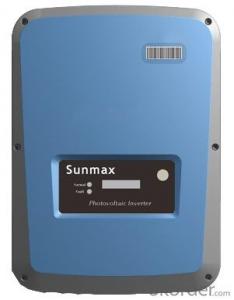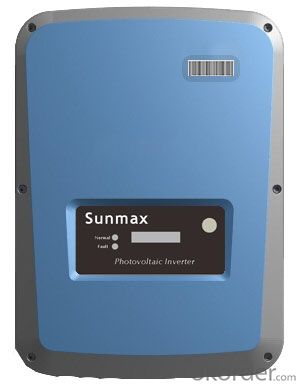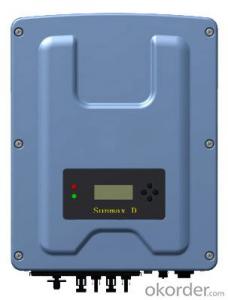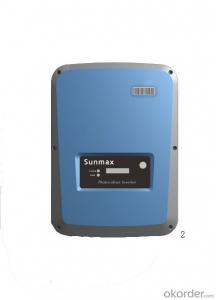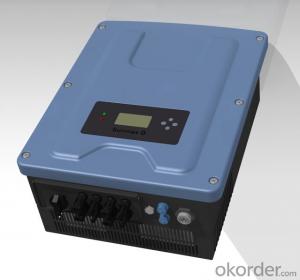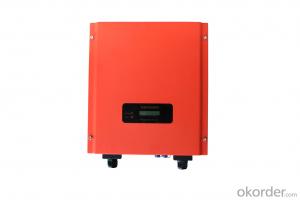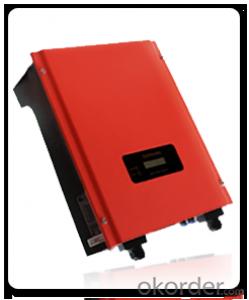3kW Solar Inverter - Sunmax PV Inverter 1500/2500/3600/4600
- Loading Port:
- Shanghai
- Payment Terms:
- TT OR LC
- Min Order Qty:
- 5 watt
- Supply Capability:
- 3000 watt/month
OKorder Service Pledge
OKorder Financial Service
You Might Also Like
Product Details
Sunmax 1500/2500/3600/4600 series are string type solar inverters for home grid connected solar generation systems. The Sunmax 1.5-5Kw series products are both reliable and good looking, have excellent technical characteristics and can be installed either indoors or outdoors.
High Efficiency:
The maximum efficiency of the inverter is up to 97.6%.
Single MPPT
Transfomer-less design
Wide range of MPPT voltage
Safe:
The units have built-in leakage current monitoring devices.
Units use thin-film capacitors ensuring better product performance.
IP65 protection class
Optional DC switch
Flexible:
Indoor and outdoor installation option
Multilingual LCD display for the user to select
Hanging design makes installation easy.
RS485 integrated interface and the Bluetooth communication module makes the units convenient for monitoring
- Q: Can a solar inverter be used with a solar-powered air conditioner?
- Yes, a solar inverter can be used with a solar-powered air conditioner. A solar inverter is responsible for converting the direct current (DC) electricity generated by solar panels into alternating current (AC) electricity that can be used to power appliances. In the case of a solar-powered air conditioner, the solar inverter would be essential for converting the DC electricity generated by the solar panels into AC electricity to run the air conditioner.
- Q: How does a solar inverter handle voltage and frequency variations caused by grid faults?
- A solar inverter handles voltage and frequency variations caused by grid faults through its built-in protective mechanisms and control algorithms. When a grid fault occurs, such as a voltage dip or frequency deviation, the inverter quickly detects the change and adjusts its output accordingly. It regulates the voltage and frequency of the energy it feeds into the grid, ensuring it remains within the acceptable limits even during grid faults. This helps to safeguard the stability and integrity of the grid system and prevents any potential damage to the inverter or connected devices.
- Q: How does a solar inverter handle variations in ambient temperature?
- A solar inverter handles variations in ambient temperature by incorporating temperature compensation mechanisms. These mechanisms allow the inverter to adjust its operation and optimize performance based on the temperature conditions. By monitoring the temperature, the inverter can regulate voltage levels, adjust power outputs, and protect itself from overheating. This ensures that the inverter operates efficiently and reliably under different ambient temperature conditions.
- Q: What is the warranty period for a solar inverter?
- The warranty period for a solar inverter can vary depending on the brand and model. However, it is common for solar inverters to come with a warranty period of 5 to 10 years.
- Q: How does a solar inverter handle voltage sag or drop in the grid?
- A solar inverter handles voltage sag or drop in the grid by continuously monitoring the grid voltage. When it detects a voltage sag or drop, the inverter quickly adjusts its output voltage to compensate for the fluctuation, ensuring a stable and consistent power supply. This is achieved by utilizing the inverter's control algorithms and power electronics to regulate the output voltage and maintain grid compatibility.
- Q: What is the role of a solar inverter in a grid-tied system?
- The role of a solar inverter in a grid-tied system is to convert the direct current (DC) electricity produced by the solar panels into alternating current (AC) electricity that can be used by the electrical grid or consumed by the appliances and devices in a home or business. It also ensures that the solar energy generated is synchronized with the grid's voltage and frequency to enable efficient and safe transfer of power. Additionally, the solar inverter monitors and controls the flow of electricity between the solar panels, the grid, and any energy storage systems that may be connected to the system.
- Q: How do you calculate the maximum power point tracking range for a solar inverter?
- To calculate the maximum power point tracking (MPPT) range for a solar inverter, you need to consider various factors such as the solar panel's voltage and current characteristics, temperature, and the inverter's efficiency. Using the voltage-current (V-I) curve of the solar panel, the MPPT range can be determined by finding the point where the power output is maximized. This is typically done using algorithms within the solar inverter to continuously adjust the operating point to track the maximum power available from the solar panel.
- Q: How does a solar inverter handle voltage unbalance?
- A solar inverter handles voltage unbalance by continuously monitoring the grid voltage levels and adjusting its output accordingly. If it detects any voltage imbalance, it dynamically regulates the output voltage to balance the system. This ensures that the inverter operates within the acceptable voltage limits, prevents damage to the connected devices, and maintains efficient energy conversion.
- Q: Can a solar inverter be used with a solar-powered data center?
- Yes, a solar inverter can be used with a solar-powered data center. A solar inverter is an essential component that converts the direct current (DC) produced by solar panels into alternating current (AC) that can be used to power electrical equipment, including data centers. By integrating a solar inverter into the solar power system of a data center, the generated solar energy can be efficiently used to run the center's operations, reducing reliance on grid electricity and promoting sustainability.
- Q: Can a solar inverter be used with concentrated photovoltaic systems?
- Yes, a solar inverter can be used with concentrated photovoltaic (CPV) systems. However, the inverter used for CPV systems may differ from the ones used for traditional photovoltaic systems. CPV systems use lenses or mirrors to concentrate sunlight onto highly efficient solar cells, which generate DC power. This DC power is converted into AC power by the inverter, enabling it to be used for various applications or fed into the grid. Therefore, a specialized inverter designed to handle the unique characteristics and high levels of DC power output of CPV systems is required.
Send your message to us
3kW Solar Inverter - Sunmax PV Inverter 1500/2500/3600/4600
- Loading Port:
- Shanghai
- Payment Terms:
- TT OR LC
- Min Order Qty:
- 5 watt
- Supply Capability:
- 3000 watt/month
OKorder Service Pledge
OKorder Financial Service
Similar products
Hot products
Hot Searches
Related keywords
